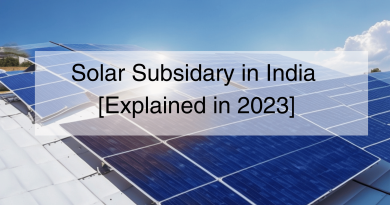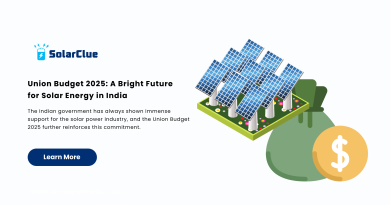Solar Grid Tie Inverter
In today’s world, solar energy is no longer a distant dream but a reality that’s powering millions of homes and businesses globally. The idea of using the sun’s energy to reduce electricity bills and contribute to a cleaner environment is exciting, right? But there’s one key piece of technology that makes all of this possible—the solar grid tie inverter.
You might have heard about solar panels, but what about the solar grid tie inverter? This small yet powerful device plays a big role in transforming solar energy into usable electricity. Whether you’re curious about how solar power works or planning to install a solar system for your home, understanding the solar grid tie inverter is crucial.
Let’s dive into the world of solar grid tie inverters and explore how they work, why they are important, and how they fit into a solar power system!
Table of Contents
What is a Solar Grid Tie Inverter?
A solar grid tie inverter is a device that connects a solar power system to the public electricity grid. It takes the direct current (DC) electricity produced by solar panels and converts it into alternating current (AC), which is the type of electricity that powers your home appliances and is compatible with the grid.
Unlike an off-grid system, which stores power in batteries, a grid-tied system sends excess energy back to the grid. In return, you often get credit or money from the utility company, which helps reduce your overall electricity bill. Pretty cool, right?
Why Do You Need It?
Here’s why a solar grid tie inverter is essential:
- Conversion of Power: Solar panels produce DC power, but our homes run on AC. Without the inverter, the energy generated by solar panels wouldn’t be usable.
- Grid Connectivity: It seamlessly connects your solar system to the grid, allowing you to feed excess electricity back to the grid.
- Net Metering: With a grid tie inverter, you can participate in net metering programs, where the extra power you generate earns you credits on your electricity bill.
How Does a Solar Grid Tie Inverter Work?
Think of a solar grid tie inverter as the middleman between your solar panels and the power grid. Here’s a step-by-step breakdown of how it works:
- Solar Panels Capture Sunlight: Solar panels, made up of photovoltaic (PV) cells, absorb sunlight and convert it into DC electricity.
- Inverter Converts DC to AC: The solar grid tie inverter steps in and transforms this DC power into AC, which is the standard form of electricity used in homes and the grid.
- Electricity Powers Your Home: The converted AC electricity is then sent to your home’s electrical system to power lights, appliances, and other devices.
- Excess Energy Goes to the Grid: If your solar panels produce more energy than you need, the extra electricity is automatically sent to the grid, and you receive credits for it through net metering.
In this system, there are no batteries involved. Instead, you rely on the grid to store your excess energy, and you draw from the grid when your solar panels aren’t generating enough power, such as at night.
Advantages of Using a Solar Grid Tie Inverter
Now that you know what a solar grid tie inverter is and how it works, let’s explore the key advantages:
- Lower Electricity Bills: One of the biggest benefits is the reduction in electricity bills. Since you’re generating your own power, the amount of electricity you need to buy from the grid decreases, which means lower bills.
- Earn Credits through Net Metering: Any excess power you produce goes to the grid, and you earn credits that further reduce your bill. In some cases, you might even get paid by your utility company!
- No Batteries Needed: Grid-tied systems do not require expensive batteries to store energy. Instead, you can use the grid as your backup storage. This makes the system cheaper and easier to maintain.
- Reduce Carbon Footprint: By using solar energy, you’re cutting down on the amount of fossil fuels needed to generate electricity. This is a great way to reduce your carbon footprint and contribute to a healthier planet.
- Easier Installation: Compared to off-grid systems, grid-tied solar systems are easier and faster to install since there are no batteries or complex wiring required.
Challenges of Using a Solar Grid Tie Inverter
While there are plenty of benefits, a solar grid tie inverter system isn’t without its challenges:
- Power Outages: If the grid goes down, your solar system won’t work. This is because the grid tie inverter shuts down during outages to prevent backfeeding power into the grid, which could endanger repair workers.
- Limited Backup Power: Unlike off-grid systems that store energy in batteries, a grid-tied system doesn’t provide backup power during an outage unless paired with a separate battery backup.
- Dependent on Sunlight: Since the system relies on sunlight, its efficiency may decrease during cloudy days or the winter months when sunlight is less intense.
Solar Grid Tie Inverter vs. Off-Grid Inverter
To understand solar inverters better, let’s compare grid-tied and off-grid inverters:
| Feature | Grid Tie Inverter | Off-Grid Inverter |
|---|---|---|
| Connection to Grid | Connected to the electricity grid | Not connected to the grid |
| Battery Requirement | No need for batteries | Requires batteries for energy storage |
| Power Backup | No power during outages | Provides backup power with batteries |
| Cost | Generally lower cost due to no battery | Higher cost due to battery storage |
| Energy Selling | Can sell excess energy to the grid | Cannot sell energy, self-reliant |
| Complexity | Simple installation | More complex due to battery system |
This table highlights how grid-tied inverters are simpler and more cost-effective for most homeowners, while off-grid systems are better for those looking to be completely independent of the grid.
Is a Solar Grid Tie Inverter Right for You?
If you’re thinking about installing a solar power system, it’s worth considering whether a grid tie inverter is the best option for you. Here’s a quick checklist to help you decide:
- Do you have access to a public electricity grid? If yes, a grid tie inverter is a perfect choice. If not, you’ll need an off-grid system.
- Do you want to lower your electricity bills? Grid-tied systems are great for reducing energy costs.
- Are power outages common in your area? If yes, you might want to consider adding a battery backup for your grid-tied system to ensure you have power during blackouts.
Conclusion
Solar energy is a powerful and sustainable solution for homes and businesses, but understanding how it works is crucial for maximizing its benefits. The solar grid tie inverter is a key component in converting solar energy into usable electricity and connecting your system to the grid. With the ability to lower energy bills, reduce carbon footprints, and make use of net metering, a grid-tied solar system is an attractive option for many.
Whether you’re new to solar power or considering an upgrade to your current system, knowing how a solar grid tie inverter works helps you make informed decisions and take full advantage of the energy savings it offers.
Visit SolarClue® to see the Best Solar inverter. SolarClue® actively sells solar energy products at discounts of up to 50% on its online marketplace.
FAQ
1. Can I use a solar grid tie inverter during a power outage?
No, a solar grid tie inverter shuts down during a power outage for safety reasons, unless you have a battery backup system.
2. What is the lifespan of a solar grid tie inverter?
Most solar grid tie inverters last between 10 to 15 years, though some high-quality models may last longer with proper maintenance.
3. Do I need batteries for a grid-tied solar system?
No, batteries are not required for grid-tied systems, as the grid serves as your backup.
4. How much does a solar grid tie inverter cost?
Prices vary depending on the size and brand, but you can expect to pay between $1,000 to $3,000 for a standard solar grid tie inverter.
5. Can I sell excess solar energy to the grid?
Yes, with a grid-tied system, you can send excess energy to the grid and earn credits through net metering programs.
By understanding how a solar grid tie inverter works and the benefits it offers, you’re one step closer to enjoying the financial and environmental rewards of solar energy. Whether for a small household or a larger business, the simplicity and efficiency of a grid-tied system make it a smart investment for the future!




